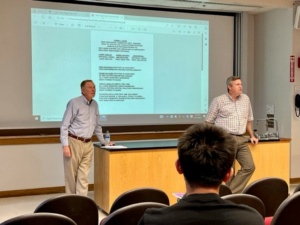During a cross-country trip, Dr. Tony Hugli stopped in Bloomington for a couple of crisp fall days in mid-October, 2023. The Department and College were thrilled to host Dr. Hugli. He enjoyed a lab tour, including the spaces that he studied in for his Ph.D. 55 years ago in our building, although those labs have now been repurposed. Dr. Hugli met with a group of 32 current graduate students and shared experiences from his career and took questions about how to build an exciting and impactful career based on an IU Chemistry Ph.D. The students enjoyed his stories and hearing about key decision points in his career. The Department is grateful to Dr. Hugli for spending this time with us and for his support of our Department.
Dr. Tony Hugli graduated from IU Chemistry with a Ph.D. in 1968. He studied at IU with Prof. Frank R. N. Gurd at both the IU School of Medicine in Indianapolis and at IU Chemistry in Bloomington. Dr. Hugli came to IU from Ohio, where he grew up in a small farming community and studied for a BS degree at Otterbein College. Following his studies at IU, Dr. Hugli worked as a postdoctoral fellow at Rockefeller University in New York City from 1968-1972, where he studied in the labs of William H. Stein and Stanford Moore (Nobel in Chemistry, 1972). One of his projects was to develop a method to quantitatively determine tryptophan in protein. Tryptophan is partially destroyed during acid hydrolysis, so he devised an alkaline method (J. Biol. Chem. 247, 2828-2834, 1972). This technique was picked up by Russia to select high tryptophan grains for improved nutritional value because, like lysine, tryptophan is an essential amino acid. Dr. Hugli jokes that he is more famous in Russia than in America! Most of the grains now grown have been selected for high tryptophan and lysine content.
In 1972, Dr. Hugli accepted a position at the Scripps Research Institute and set up the first protein chemistry lab there. He was in the Immunology Department working mainly on the blood complement system. His lab isolated and characterized the anaphylatoxins (C3a, C4a, and C5a), C5a being the main chemotactic factor in host defense inflammation (leukocyte recruitment). This was before any cell-derived cytokines had been isolated. Because the anaphylatoxins were implicated in allergy via mast cell histamine release and inflammation via leukocyte recruitment, Dr. Hugli and his team were well recognized and invited to speak at meetings all over the world. In 1981, Dr. Hugli was one of 12 American biochemists invited to Shanghai for a meeting at the Shanghai Institute sponsored by the Chinese government.
Dr. Hugli credits his graduate training at IU as contributing to “a wonderful career in science.”

